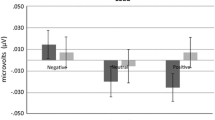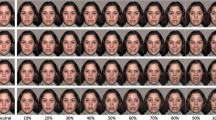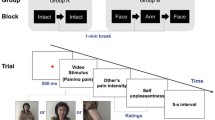Abstract
The hypotheses of this investigation were based on conceiving of facial mimicry reactions in face-to-face interactions as an early automatic component in the process of emotional empathy. Differences between individuals high and low in emotional empathy were investigated. The parameters compared were facial mimicry reactions, as represented by electromyographic (EMG) activity, when individuals were exposed to pictures of angry or happy faces. The present study distinguished between spontaneous facial reactions and facial expressions associated with more controlled or modulated emotions at different information processing levels, first at a preattentive level and then consecutively at more consciously controlled levels: 61 participants were exposed to pictures at three different exposure times (17, 56, and 2350 ms). A significant difference in facial mimicry reactions between high- and low-empathy participants emerged at short exposure times (56 ms), representing automatic, spontaneous reactions, with high-empathy participants showing a significant mimicking reaction. The low-empathy participants did not display mimicking at any exposure time. On the contrary, the low-empathy participants showed, in response to angry faces, a tendency to an elevated activation in the cheek region, which often is associated with smiling.
Similar content being viewed by others
References
Bäckström, M., & Holmes, B. (1999). Measuring adult attachment: A construct validation of two self-report instruments. Scandinavian Journal of Psychology, 42, 79–86.
Barnett, M. A., Howard, J. A., King, L. M., & Dino, G. A. (1981). Helping behaviour and the transfer of empathy. The Journal of Social Psychology, 115, 125–132.
Bartholomew, K., & Horowitz, L. M. (1991). Attachment styles among young adults: A test of a four-category model. Journal of Personality and Social Psychology, 61, 226–244.
Basch, M. F. (1976). Psychoanalysis and communication science. The Annals of Psychoanalysis, 31, 101–126.
Basch, M. F. (1983). Empathic understanding: A review of the concept and some theoretical considerations. Journal of the American the Psychoanalytical Association, 31, 101–126.
Bavelas, J. B., Black, A., Lemery, C. R., & Mullett, J. (1986). "I show how you feel": Motor mimicry as a communicative act. Journal of Personality and Social Psychology, 50, 322–329.
Blairy, S., Herrera, P., & Hess, U. (1999). Mimicry and the judgement of emotional facial expressions. Journal of Nonverbal Behavior, 23, 5–41.
Brown, J. W. (1985). Clinical evidence for the concept of levels of action and perception. Journal of Neurolinguistics, 1, 89–141.
Brown, J. W. (1988). Life of the mind. Selected papers. Englewood Cliffs, NJ: Prentice-Hall.
Brown, S. L., & Schwartz, G. E. (1980). Relationships between facial electromyography and subjective experience during affective imagery. Biological Psychology, 11, 49–62.
Buck, R. (1984). The communication of emotion. New York: Guilford.
Buck, R. (1994). The neuropsychology of communication: Spontaneous and symbolic aspects. Journal of Pragmatics, 22, 256–278.
Buck, R., & Ginsberg, B. (1991). Emotional communication and altruism: The communicative gene hypotheses. In M. S. Clark (Ed.), Altruism. Review of personality and social psychology (Vol. 11, pp. 149–175). Newbury Park, CA: Sage.
Burgoon, J. K., Buller, D. B., & Woodall, W. G. (1996). Nonverbal communication: The unspoken dialogue. New York: McGraw-Hill.
Cacioppo, J. T., Klein, D. J., Berntsson, G. G., & Hatfield, E. (1993). The psychophysiology of emotion. In M. Lewis & J. M. Haviland (Eds.), Handbook of emotions (pp. 119–142). New York: The Guilford Press.
Cacioppo, J. T., Matzke, J. S., Petty, R. E., & Tassinary, L. G. (1988). Specific forms of facial EMG response index emotions during an interview: From Darwin to the continuous flow of affect laden information processing. Journal of Personality and Social Psychology, 54, 592–604.
Cacioppo, J. T., Petty, R. E., Losch, M. E., & Kim, H. S. (1986). Electromyographic activity over facial muscle regions can differentiate the valence and the intensity of affective reactions. Journal of Personality and Social Psychology, 50, 260–268.
Capella, J. N. (1993). The facial feed back hypotheses in human interaction: Review and speculation. Journal of Language and Social Psychology, 12, 13–29.
Chartrand, T. L., & Bargh, J. A. (1999). The chameleon effect: The perception-behavior link and social interaction. Journal of Personality and Social Psychology, 76, 893–910.
Chlopan, B. E., McCain, M. L., Carbonell, J. L., & Hagen, R. L. (1985). Empathy: Review of available measures. Journal of Personality and Social Psychology, 48, 635–653.
Darwin, C. (1872, 1965). The expression of emotion in man and in animals. Chicago: University of Chicago Press.
Dimberg, U. (1982). Facial reactions to facial expressions. Psychophysiology, 19, 643–647.
Dimberg, U. (1989). Facial expressions and emotional reactions: A psychobiological analysis of human social behaviour. In H. L. Wagner (Ed.), Social psychophysiology and emotion: Theory and clinical applications (Vol. 36, pp. 132–149). London: John Wiley & Sons Ltd.
Dimberg, U. (1997a). Psychophysiological reactions to facial expressions. In U. Segerstråle & P. Molnar (Eds.), Nonverbal communication: Where nature meets culture (pp. 47–60). Mahwah, NJ: Lawrence Erlbaum Associates, Inc.
Dimberg, U. (1997b). Social fear and expressive reactions to social stimuli. Scandinavian Journal of Psychology, 38, 171–174.
Dimberg, U., & Karlsson, B. (1997). Facial reactions to different emotionally relevant stimuli. Scandinavian Journal of Psychology, 38, 297–303.
Dimberg, U., & Öhman, A. (1996). Behold the wrath: Psychophysiological responses to facial stimuli. Motivation and Emotion, 20, 149–182.
Dimberg, U., Thunberg, M., & Elmehed, K. (2000). Unconscious facial reactions to emotional facial expressions. Psychological Science, 11, 86–89.
Dixon, N. F. (1981). Preconscious processing. New York: John Wiley & Sons.
Eisenberg, N., & Fabes, R. (1990). Empathy: Conceptualization, measurement, and relation to prosocial behavior. Motivation and Emotion, 14, 131–150.
Eisenberg-Berg, N., & Mussen, P. (1978). Empathy and moral development in adolescence. Developmental Psychology, 14, 185–186.
Ekman, P. (1989). The argument and evidence about universals in facial expressions of emotion. In J. Wagner & A. Manstead (Eds.), Handbook of social pychophysiology (pp. 143–164). New York: Wiley.
Ekman, P. (1994). Strong evidence for universals in facial expressions: A reply to Russell's mistaken critique. Psychological Bulletin, 115, 268–287.
Ekman, P., & Friesen, W. V. (1969). The repertoire of nonverbal behavior: Categories, usage, and coding. Semiotica, 1, 49–98.
Ekman, P., & Friesen, W. V. (1975). Unmasking the face. Englewood Cliffs, NJ: Prentice-Hall.
Ekman, P., & Friesen, W. (1978). Facial action coding system: A technique for the measurement of facial movement. Palo Alto, CA: Consulting Psychology Press.
Ekman, P., & Friesen, W. V. (1982). Felt, false, and miserable smiles. Journal of Nonverbal Behavior, 6, 638–252.
Ekman, P., Friesen, W. V., & Ancoli, S. (1980). Facial signs of emotional experience. Journal of Personality and Social Psychology, 39, 1125–1134.
Ekman, P., Levenson, R., & Friesen, W. V. (1983). Autonomic nervous system activity distinguishes among emotions. Science, 221, 1208–1210.
Englis, B. G., Vaughan, K. B., & Lanzetta, J. T. (1982). Conditioning of counterempathic emotional responses. Journal of Experimental Social Psychology, 18, 375–391.
Esteves, F., & Öhman, A. (1993). Masking the face: Recognition of emotional facial expressions as a function of the parameters of backward masking. Scandinavian Journal of Psychology, 34, 1–18.
Eysenck, M. W., & Keane, M. T. (1995). Cognitive psychology. Hillsdale, NJ: Lawrence Erlbaum Associates Publishers.
Eysenck, S. B. G., & Eysenck, H. J. (1978). Impulsiveness and venturesomeness: Their position in a dimensional system of personality description. Psychological Reports, 43, 1247–1255.
Fridlund, A. J., & Cacioppo, J. T. (1986). Guidelines for human electromyographic research. Psychophysiology, 23, 567–589.
Gallese, V. (2001). The "shared manifold" hypothesis: From mirror neurons to empathy. Journal of Consciousness Studies, 8, 33–50.
Ginsburg, G. P. (1997). Faces: An epilogue and reconceptualization. In J. A. Russell & J. M. Fernández-Dols (Eds.), The psychology of facial expression (pp. 349–382). New York: Cambridge University Press.
Griffin, D., & Bartholomew, K. (1994). The metaphysics of measurement: The case of adult attachment. In K. Bartholomew, & D. Perlman (Eds.), Attachment processes in adulthood: Advances in personal relationships (Vol. 5, pp. 17–52). London, UK: Jessica Kingsley Publisher Ltd.
Hatfield, E., Cacioppo, J., & Rapson, R. L. (1992). Emotional contagion. In M. S. Clark (Ed.), Review of personality and social psychology: Emotion and social behavior (Vol. 14, pp. 151–177). Newbury Park, CA: Sage.
Hatfield, E., Cacioppo, J. T., & Rapson, R. L. (1994). Emotional contagion. New York: Cambridge University Press.
Hess, U., Banse, R., & Kappas, A. (1995). The intensity of facial expression is determined by underlying affect and the social situation. Journal of Personality and Social Psychology, 69, 280–288.
Hess, U., Kappas, A., McHugo, G. J., Lanzetta, J. T., & Kleck, R. E. (1992). The facilitative effects of facial expressions on the self-generation of emotion. International Journal of Psychophysiology, 12, 251–265.
Hess, U., Philippot, P., & Blairy, S. (1998). Facial reactions to emotional facial expressions: Affect or cognition? Cognition and Emotion, 12, 509–531.
Hess, U., Philippot, P., & Blairy, S. (1999). Mimicry: Facts and fictions. In R. S. Philippot, R. S. Feldman, & E. J. Coats (Eds.), The social context of nonverbal behavior (pp. 213–241). Cambridge: Cambridge University Press.
Hjortsjö, C. H. (1970). Man's face and mimic language. Malmö: Nordens Boktryckeri.
Hofer, M. (1984). Relationships as regulators: A psychobiologic perspective on bereavement. Psychosomatic Medicine, 46, 183–197.
Hoffman, M. L. (1984). Interaction of affect and cognition on empathy. In C. E. Izard, J. Kagan, & R. B. Zajonc (Eds.), Emotions, Cognition and Behavior (pp. 101–131). New York: Cambridge University Press.
Hsee, C. K., Hatfield, E., & Chemtob, C. (1992). Assessments of the emotional states of others: Conscious judgements versus emotional contagion. Journal of Social and Clinical Psychology, 11, 119–128.
Izard, C. E. (1971). The face of emotion. New York: Appelton-Century-Crofts.
Izard, C. E. (1990). Facial expressions and the regulation of emotions. Journal of Personality and Social Psychology, 58, 487–498.
Izard, C. E. (1994). Innate and universal facial expressions: Evidence from developmental and cross-cultural research. Psychological Bulletin, 115, 288–299.
Kappas, A., Hess, U., & Banse, R. (1992). Skin conductance reactions to dynamic facial expressions revisited: Empathic responding or information processing? Psychophysiology, 29, 42.
Keltner, D., & Ekman, P. (2000). Facial expression of emotion. In M. Lewis & J. M. Haviland-Jones (Eds.), Handbook of emotions (pp. 236–249). New York: The Guilford Press.
Kragh, U., & Smith, G. J. W. (1970). Percept-genetic analysis. Lund, Sweden: Gleerup.
Laird, J. D. (1974). Self-attribution of emotion: The effects of expressive behavior on the quality of emotional experience. Journal of Personality and Social Psychology, 37, 475–486.
Laird, J. D., Alibozak, T., Davainis, D., Deignan, K., Fontanella, K., Hong, J., Brett, L., & Pacheco, C. (1994). Individual differences in the effects of spontaneous mimicry on emotional contagion. Motivation and Emotion, 18, 231–245.
Lang, P. J., Greenwald, M. K., Bradley, M. M., & Hamm, A. O. (1993). Looking at pictures: Affective, facial, visceral and behavioral reactions. Psychophysiology, 30, 261–273.
Lanzetta, J. T., & Englis, B. G. (1989). Expectation of cooperation and competition and their effects on observers' vicarious emotional responses. Journal of Personality and Social Psychology, 46, 543–554.
Lanzetta, J. T., & Kleck, R. E. (1976). Effects of nonverbal dissimulation on emotional experience and autonomic arousal. Journal of Personality and Social Psychology, 33, 354–370.
LeDoux, J. (1996). The emotional brain, The mysterious underpinnings of emotional life. New York: Simon & Schuster.
Levenson, R. W. (1996). Biological substrates of empathy and facial modulation of emotion: Two facets of the scientific legacy of John Lanzetta. Motivation and Emotion, 20, 185–204.
Leventhal, H. (1984). A perceptual motor theory of emotion. Advances in experimental social psychology (Vol. 17, pp. 117–182). Madison, WI: Academic Press, Inc.
Lipps, T. (1903). Kapitel: Die einfühlung in leitfaden der psychology. Leipzig: Verlag von Wilhem Engelmann.
Lundqvist, L.-O. (1995). Facial EMG reactions to facial expressions: A case of emotional contagion? Scandinavian Journal of Psychology, 36, 130–141.
Matsumoto, D. (1987). The role of the facial response in experience of emotion: More methodological problems and meta-analysis. Journal of Personality and Social Psychology, 52, 769–774.
Matsumoto, D., & Lee, M. (1991). Consciousness, volition and the neuropsychology of facial expression and emotion. Consciousness and Cognition, 2, 237–254.
McHugo, G. J., & Smith, C. A. (1996). The power of faces: A review of John T. Lanzetta's research on facial expression and emotion. Motivation and Emotion, 20, 85–119.
McIntosh, D. N. (1996). Facial feedback hypotheses: Evidence, implications, and directions. Motivation and Emotion, 20, 121–147.
Mehrabian, A., & Epstein, N. (1972). A measure of emotional empathy. Journal of Personality, 40, 525–543.
Öhman, A. (1993). Fear and anxiety as emotional phenomena: Clinical phenomenology, evolutionary perspectives and information processing mechanisms. In M. Lewis & J. M. Haviland (Eds.), Handbook of emotion (pp. 511–536). New York: The Guilford Press.
Öhman, A., & Dimberg, U. (1978). Facial expression as conditioned stimuli for electrodermal responses. A case of "preparedness"? Journal of Personality and Social Psychology, 36, 1251–1258.
Pally, R. (1998). Emotional processing: The mind-body connection. Journal of Psychoanalysis, 79, 349–362.
Porges, S. W. (1991). Vagal tone: An automatic mediator of affect. In J. Garber & K. A. Dodge (Eds.), The development of emotion regulation and dysregulation (pp. 111–127). Cambridge: Cambridge University Press.
Schore, A. N. (1994). Affect regulation and the origin of the self. Hillsdale, NJ: Lawrence Erlbaum Associates Publisher.
Sonnby-Borgström, M. (2002a). Between Ourselves. Automatic mimicry reactions as related to empathic ability and patterns of attachment. Doctoral thesis, Lund University, Lund.
Sonnby-Borgström, M. (2002b). Automatic mimicry reactions as related to differences in emotional empathy. Scandinavian Journal of Psychology, 43, 433–443.
Sonnby-Borgström, M., & Jönsson, P. (2003). Model-of-self and model-of-others as related to facial muscle reactions at different levels of cognitive control. Scandinavian Journal of Psychology, 44, 153–163
Tassinary, L. G., & Cacioppo, J. T. (1992). Unobservable facial actions and emotion. Psychological Science, 3, 28–33.
Tassinary, L. G., & Cacioppo, J. T. (2000). The skeletomotor system: Surface electromyography. In J. T. Cacioppo, L. G. Tassinary, & G. G. Berntsson (Eds.), Handbook of psychophysiology (pp. 163–199). Cambridge: Cambridge University Press.
Tassinary, L. G., Cacioppo, J. T., & Geen, T. R. (1989). A psychometric study of surface electrode placements for facial electromyographic recording. Psychophysiology, 24, 1–16.
Tassinary, L. G., Scott, P. O., Wolford, G., Napps, S. E., & Lanzetta, J. T. (1984). The role of awareness in affective information processing: An exploration of the Zajonc hypothesis. Bullentin of Psychonomic Society, 22, 489–492.
Tomkins, S. (1984). Affect theory. In K. Scherer & P. Ekman (Eds.), Approaches to emotion (pp. 353–400). Hillsdale, NJ: Erlbaum.
Tomkins, S. (1991). Affect, imagery and consciousness. New York: Springer Publishing Company.
Trevarthen, C. (2001). Intrinsic motives for companionship in understanding: Their origin, development, and significance for infant mental health. Infant Mental Health, 22(1–2), 95–131.
Vaughan, K. B., & Lanzetta, J. T. (1980). Vicarious instigation and conditioning of facial expressive automatic responses to a model's expressive display of pain. Journal of Personality and Social Psychology, 38, 909–923.
Williams, J. H. G., Whiten, A., Suddendorf, T., & Perrett, D. I. (2001). Imitation, mirror neurons and autism. Neuroscience and Biobehavioural Reviews, 25, 287–295.
Wolf, N. S., Gales, M. E., Shane, E., & Shane, M. (2001). The developmental trajectory from amodal perception to empathy and communication: The role of mirror neurons in this process. Psychoanalytic Inquiry, 21, 94–112.
Wood, J. V., Salzberg, J. A., & Goldsamt, L. A. (1990). Does affect induce self-focused attention? Journal of Personality and Social Psychology, 58, 899–908.
Vrana, R. S., & Rollock, D. (1998). Physiological response to a minimal social encounter: Effects of gender, ethnicity and social context. Phychophysiology, 35, 462–469.
Zajonc, R. B. (1980). Feeling and thinking. Preferences need no inferences. American Psychologist, 35, 151–175.
Zajonc, R. B. (1985). Emotion and facial efference: A theory reclaimed. Science, 228, 15–21.
Zajonc, R. B., Adelmann, K. A., Murphy, S. T., & Niedenthal, P. M. (1987). Convergence of the physical appearence of spouses. Motivation and Emotion, 11, 335–346.
Author information
Authors and Affiliations
Corresponding author
Rights and permissions
About this article
Cite this article
Sonnby-Borgström, M., Jönsson, P. & Svensson, O. Emotional Empathy as Related to Mimicry Reactions at Different Levels of Information Processing. Journal of Nonverbal Behavior 27, 3–23 (2003). https://doi.org/10.1023/A:1023608506243
Issue Date:
DOI: https://doi.org/10.1023/A:1023608506243




